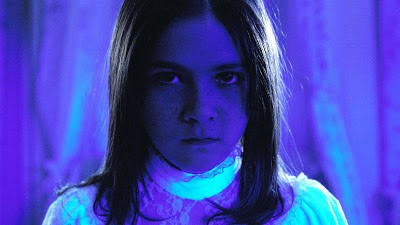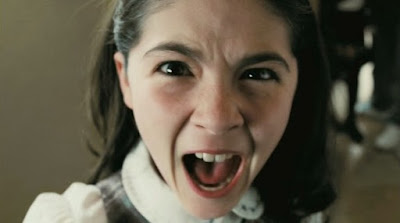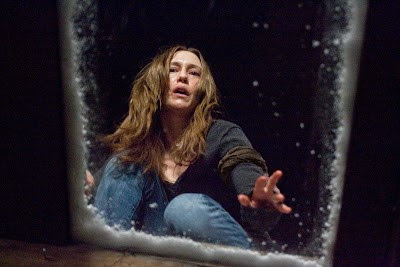FOR HALLOWEEN: ORPHAN
Halloween doesn’t
have to be over once the last trick-or-treater has crept back into the shadows
of the night. You may still be possessed by the spirit of the holiday and in
desperate need of some real scares. In an effort to address that need and help
you find a choice that goes beyond the usual iconography of the season, I’ve
picked three titles that may not immediately jump to mind when it comes to
autumn-tinged chills and terror. They are not self-consciously seasonal choices,
like John Carpenter’s Halloween or
Michael Dougherty’s 2007 anthology Trick
‘R Treat, both excellent choices for cinematic fear on the pumpkin circuit.
Two of them rely more on mood, creeping dread, an insinuating style and, dare I
say, even a poetic approach to storytelling than the usual Samhain-appropriate
fare. And one has an inexplicably bad reputation in the halls of conventional
wisdom, accused of being repellent and tastelessly disturbing when it is in
fact repellent, pointedly disturbing and entirely, rousingly effective in the
shock and scare department, complete with a third-act twist that, if it hasn’t
somehow already been spoiled for you, you will likely never guess. So when
you’re ready, unpack the leftover trick-or-treat candy, get under the blanket
and get ready. One of these—perhaps all three—will be just ticket to freeze
your blood one last time before the more benign portion of our holiday season
begins. You have been warned.
Horror movies are a great ticket during the summer months (and when the summer heat extends well into fall, as it customarily does here in Los Angeles), because a really good screamer, like Sam Raimi’s Drag Me to Hell, can give you the kind of deep-seated chills that go way beyond the cooling of the skin provided by central air. And bless your soon-to-be-rotted soul if you can get your claws on one that happens to be set in a wintry environment, thus inviting the visual component to conspire with the narrative to bring your body temperature down to grave-worthy levels. Movies like The Brood (1979), The Dead Zone (1983)-- David Cronenberg does seem to have a way with the desolate chill of winter-- The Thing (versions 1951 and 1982), the climax of Dracula: Prince of Darkness (1966), one particularly icy moment involving Lew Ayres from Damien: Omen II (1978), Let the Right One In (2008) and Matt Reeves’ stunningly good remake Let Me In (2010), which trades the Swedish frost for a New Mexico variety, and last but certainly not least 2008’s woefully underappreciated The X-Files: I Want to Believe (2008)—these are all excellent examples of how to use a frozen landscape to accentuate and inform a sense of dread and fear.
Some of you may also remember an ABC Movie of the Week entitled A Cold Night’s Death, directed by Jerrold Freeman and starring Robert Culp and Eli Wallach as two scientists air-lifted to a remote Arctic research station who find the facility strangely abandoned, a group of research monkeys in a near-frozen state, and lots of indicators that something has not gone according to plan. This TV-movie occupies a special place in the hearts of many of my generation’s movie genre thrill-seekers, and it’s been famously difficult to find, showing up for the occasional late-night showing when local stations still actually still ran late-show movie programming, but rarely screened since infomercials became the all-nighter’s TV anesthesia of choice. (It’s now available all over YouTube.)
Feel free to add Jaume Collet-Serra’s spectacularly unnerving Orphan (2009) to that short list of superb wintry horror tales. Set in Connecticut during the blustery snowbound months, the movie knows how to exploit that frosty climate—a couple of its more harrowing outdoor set pieces are enhanced by the sense of fear created by the landscape feeling different, less hospitable, less inhabitable, more dangerous. As in those other movies, Orphan cannily externalizes the sense of things not being quite under control by plunging us into this environment so often associated with seasonal joy and familial closeness, where unexpected cracks in the ice can form under our feet, or vehicles can go sailing off slick roads into horrible peril, or toward unaware victims.
But the chill in the air surrounding Orphan is only nominally due to its frozen setting. The movie, by means psychological and cinematic, means to put a freeze on your nerves, and that it pretty handily does is a credit to an exceedingly clever script by David Leslie Johnson and Collet-Serra’s prodigious talent for throwing the audience’s expectations askew. He does perhaps rely on loud noises and the old "who’s standing behind the refrigerator/medicine cabinet door" trick a bit too much, but so much else about this tale of parental entitlement and fear is so skillfully rendered and low-down effective that I was more than willing to forgive the director this relatively venial sins.
The opening sequence of Orphan will be a very telling indicator of whether you can deal with the shocks the movie has in store. A beatific and pregnant young woman named Kate (Vera Farmiga) is being wheeled into the hospital, her loving husband John (Peter Sarsgaard) by her side, presumably toward the maternity ward where her dreams of becoming a mother are about to come true. The camera hugs the beaming Kate in close-up as a nurse pushes her along, when suddenly we see a look of distress disrupt her glowing face, slowly turning her visage away from joy into a mask of confusion and agony. Kate is obviously in increasingly sharp pain, and yet the nurse never changes the deliberate pace of the wheelchair, never acknowledges the state of her patient except to offer, in a most ghostly, noncommittal tone, “We’re so sorry for your loss, dear.” Loss?
Collet-Serra then gives us the first of many sudden shifts in perspective to come, as we see the nurse and patient inching across the wide-screen frame from the point of view of a detached observer from high above, leaving a trail of blood from the abruption occurring inside the woman’s uterine canal along the hospital’s incongruous white shag carpeting. Soon, Kate is strapped to a hospital bed and surrounded with masked surgeons and medical personnel who coolly, callously inform her that she has lost her baby and that an emergency C-section is about to begin. Her screams of denial and horror are met with the happy glance of her husband, himself done up in surgical gown and mask, who continues to aim his video camera at her despite the obviously horrific turn their blissful moment has taken. And he never stops shooting, not even when the nurse pulls a dead, blood-soaked fetus from Kate’s womb and sets it on her chest, a ghastly hello and goodbye rolled into one traumatic moment. At which point Kate screams and wakes up…
Speaking personally, as a father who has witnessed something as horrific, if not as garishly so, as what happens to Kate in her morbidly enhanced nightmare remembrance of profound loss, I had to fight the urge to bolt from the theater during this opening sequence. And had Collet-Serra continued to operate in this weirdly dissociative style of De Palma-tinged surgical theater of horror, who knows how much I could have/would have taken? Fortunately, the director gives us this peek into Kate’s tortured psyche as a way of grounding her psychologically and filling out Farmiga’s choices in playing the character in a way that a simple back story—and everyone here has a back story laced with tragedy—would not do nearly so completely. The movie is not, as one might reasonably expect from the prologue, a grisly freak show, but instead a portrait of how tragedy can unravel even the most perfect-seeming of families and make them vulnerable to outside forces that will personify and exploit the interpersonal instability and mistrust that already exists.
During her waking hours Kate, a musician with an alcohol problem who spends her days as a housewife after losing her teaching job at Yale, really is reeling from the stillbirth of a child. She and John, an architect who presumably designed their dazzling postmodern hillside home, channel the reaction to their trauma into a strong desire to adopt. The desperate zeal to patch this hole in their life with an older “sister” to join their two biological children, Daniel (Jimmy Bennett) and Max (a deaf five-year-old played by the remarkable Aryana Engineer), leads them to an orphanage with a none-too-strict policy on background checks. It’s here where they meet Esther (Isabelle Fuhrman in a shockingly good debut performance), a preternaturally self-possessed nine-year-old Russian girl who dazzles the couple with her artistic ability, her sweet nature, and the pained perspective of the lost child she projects with apparent sincerity, which plays directly into the couple’s savior fantasies of providing for a child in need.
Of course, Esther soon reveals a malevolent side. She orchestrates a playground accident that seriously injures a schoolyard enemy. She puts a bird out of its misery with a rock after Daniel wounds it and cannot bring himself to finish the job. She subtly threatens and emotionally blackmails little Max into assisting her in a series of increasing devilish deeds, at one point pulling a revolver on the guileless child. (“Want to play?” she coolly inquires, removing all but one bullet, spinning the chamber and pointing it at Max’s head. “Perhaps later.”) Something about Esther’s artistic abilities— her mastery of Tchaikovsky on the piano, her increasingly elaborate paintings— also suggests that someone has not provided the whole story on this cinematic descendant of evil little Patty McCormick, and the ones most skillfully holding back on the big picture are the cast and director of Orphan. Truly, if Ms. McCormick was The Bad Seed, there is increasingly little doubt that Esther is the worst.
If it seems I have spent too much time detailing the roots of the horror Collet-Serra and company have concocted, it’s because to reveal much more would be in violation of the pact this movie makes with its audience to peel back ever-escalating levels of disturbing, psychologically believable behavior by means of a surprising level of horror filmmaking craft. (Stay away from any review that wants to talk about the plot in any kind of detail.) Collet-Serra’s previous horror outing, the Dark Castle productions remake of House of Wax, was a decent effort, marred by a slew of obnoxious stock characters who seemed much more pleasant smothered under molten paraffin. As enjoyable as it was for us, it was apparently a waste of time for him, so much more accomplished is his work here. As I said before, Collet-Serra tends to overdo a certain variety of stock horror movie shocks, but he just as often adds an extra touch—an unexpected camera angle, a beat or two longer for us to twist in the wind before the anticipated jolt arrives with not quite the timing we expected—that enriches the sense of our being guided by someone who has a true knack for harvesting gooseflesh.
It also helps that Orphan features probably the best cast, top to bottom, of any horror movie in recent memory, from familiar faces to rosy-cheeked children who we’ve never seen before. Farmiga, an actress who I frequently find annoying, uses her reputation for portraying ineffectual authority figures (see The Departed) to throw us off the trail of what she has charted out for this character. She plumbs the depths of despair, all right, but there’s an unexpected strength, an exhilarating anger that surfaces in Kate which makes her resistance of Esther, and their ultimate conflict, fraught with multiple, creepy levels of resonance. She also expresses fear and horror extremely well, adding strange physical ticks and vocal hiccups to her flailing about that communicate the character’s disorientation and desperation with frightening, if ironic, assurance.
Sarsgaard has a more thankless role, the disbelieving spouse who is so eager to give Esther the benefit of the doubt, against all reason it sometimes seems, that he ends up in the Compromised Position of All Compromised Positions. Even so, he retains a measure of sympathy because he seems genuinely conflicted between his duty to believe his wife and his duty as an adopted father. As mentioned earlier, Bennett and particularly Engineer are excellent child actors asked to go well beyond what one might think someone so young could make believable, and they achieve their goals with brilliance. There’s even room for quality character actors like CCH Pounder as an ill-fated orphanage nun and Margo Martindale as Kate’s far-too-even-keeled therapist.
But the real praise belongs to Isabelle Fuhrman, who will, whatever else her career holds in store, forever be Esther, a child who harbors depths of foulness far deeper than we will, thanks to the clever screenplay and Fuhrman’s prepossessed facility as an actress, ever be able to accurately guess. Speaking in a light Russian accent that turns from sing-song to deathly hollow in a twitch, Fuhrman delivers the goods, drawing us in with misplaced sympathy even when we know we’re one step ahead of the hapless family in the story. The movie invites speculation throughout about Esther’s origins, her motivation, but as it becomes clearer and clearer that Collet-Serra and Johnson have something up their sleeves that is far worse than what we’ve allowed ourselves to imagine, Fuhrman rises to the occasion with a fury and a camp (as well as vamp) haughtiness that places the movie in the vicinity of one of Brian De Palma’s great sick jokes.
Late in the game, when her face grows sallow and sunken and she embarks on the final stages of an inevitable course of execution, the audience realizes, with great shock and giddy satisfaction, that we weren’t as ahead of the game as we thought. Fuhrman, so young and talented, drives home the movie’s final conceit like a stake in the audience’s collective heart, with the pitch-black glee of an instant icon of horror. All the way home from the theater, it seemed every bus kiosk was lit with her terrifying visage from the movie’s advertising campaign. But it wouldn’t have done any good to close my eyes. Esther is one for profound nightmares. So is Orphan.
(Orphan is available from Amazon streaming and on Warner Home Video Blu-ray and DVD.)
*************************************









































































